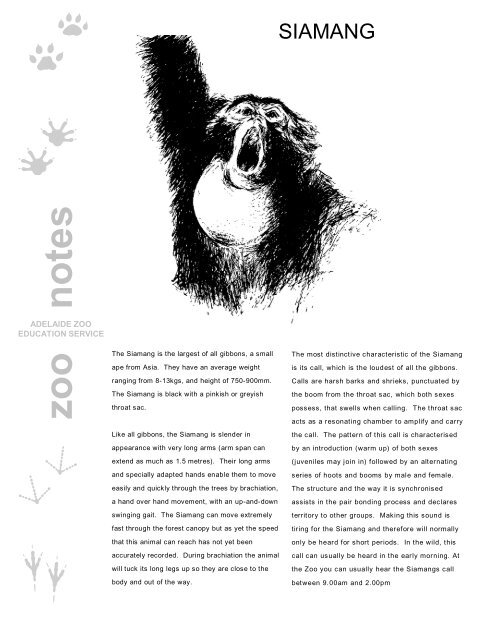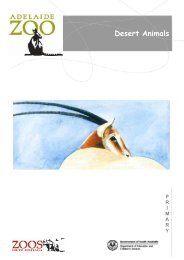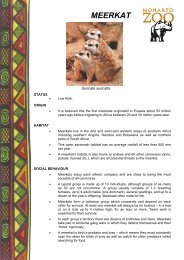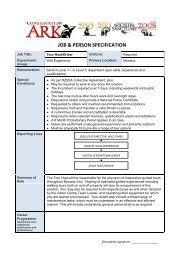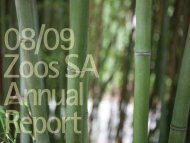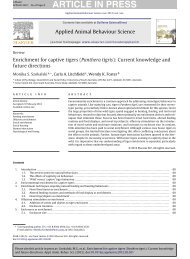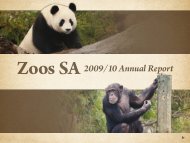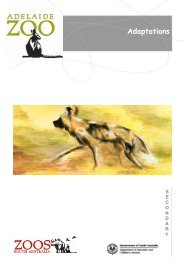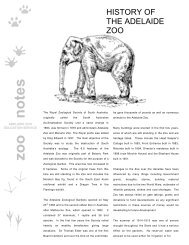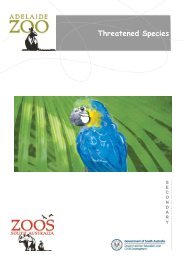Siamang - Zoos South Australia
Siamang - Zoos South Australia
Siamang - Zoos South Australia
- No tags were found...
Create successful ePaper yourself
Turn your PDF publications into a flip-book with our unique Google optimized e-Paper software.
zoo notesSIAMANGADELAIDE ZOOEDUCATION SERVICEThe <strong>Siamang</strong> is the largest of all gibbons, a smallape from Asia. They have an average weightranging from 8-13kgs, and height of 750-900mm.The <strong>Siamang</strong> is black with a pinkish or greyishthroat sac.The most distinctive characteristic of the <strong>Siamang</strong>is its call, which is the loudest of all the gibbons.Calls are harsh barks and shrieks, punctuated bythe boom from the throat sac, which both sexespossess, that swells when calling. The throat sacacts as a resonating chamber to amplify and carryLike all gibbons, the <strong>Siamang</strong> is slender inappearance with very long arms (arm span canextend as much as 1.5 metres). Their long armsand specially adapted hands enable them to moveeasily and quickly through the trees by brachiation,a hand over hand movement, with an up-and-downswinging gait. The <strong>Siamang</strong> can move extremelyfast through the forest canopy but as yet the speedthat this animal can reach has not yet beenaccurately recorded. During brachiation the animalwill tuck its long legs up so they are close to thebody and out of the way.the call. The pattern of this call is characterisedby an introduction (warm up) of both sexes(juveniles may join in) followed by an alternatingseries of hoots and booms by male and female.The structure and the way it is synchronisedassists in the pair bonding process and declaresterritory to other groups. Making this sound istiring for the <strong>Siamang</strong> and therefore will normallyonly be heard for short periods. In the wild, thiscall can usually be heard in the early morning. Atthe Zoo you can usually hear the <strong>Siamang</strong>s callbetween 9.00am and 2.00pm
The wild <strong>Siamang</strong>’s diet consists primarily of fruitsand leaves, although flowers, insects, spiders andsmall mammals may also be eaten. While hangingShould the family be moving too fast, the male willcarry the young gibbon on his back. It is also themale who teaches the baby to be independent.by one arm from a branch, the <strong>Siamang</strong> picks theripe fruits with slender fingers and leaves unripefruit for later. In the wild it has been observed thatfruits are eaten early in the day. This may be due tothe greater provision of energy from this food fordaily activity. The quantity of leaves eaten isWhen a <strong>Siamang</strong> reaches maturity, at the age of 8or 9 years, it will start to show signs of detachingitself from its parents. It will begin to sleep andmove apart from the family. When ready, the young<strong>Siamang</strong> will go out in search of its own mate.increased as the day progresses. Eating leavesrequires little energy as this food source can easilybe found.A mated pair may be accompanied by four offspringat any one time, so a family usually comprisesseveral offspring of varying ages. During their timeThe <strong>Siamang</strong> and Lar Gibbon are the only gibbonsto share the same territory. They are able tosuccessfully coexist in the wild due to their varyingdietary needs, and hence do not compete for food.with the family, the older offspring learn infant carefrom their parents and at times may be seencarrying the young. <strong>Siamang</strong>s can live for 20-30years in the wild and longer in captivity.A territorial species, <strong>Siamang</strong>s live in pairs anddefend an area of 35-40 hectares. Defenceincludes displays of acrobatics and breaking ofbranches in trees. Although twice the size of theaverage gibbon a <strong>Siamang</strong>’s home range is usuallyonly half the size. This is because up to 50% oftheir diet consists of leaves and so, with a moreGibbons depend entirely on the tropical rainforestsof <strong>South</strong> East Asia for suitable habitats to supplythem with food and shelter. In 1975 the estimatedgibbon population was 4 million. With the steadydestruction of the rainforest the estimatedpopulation of gibbons in 1990 was 600,000 anddecreasing.varied choice of food, less area to forage is needed.A family group travels up to a kilometre a day andranges between 25 and 30 metres from the ground.Social activities within this group are fairlyuncommon except for grooming and juvenile-parentThe current estimate for the <strong>Siamang</strong> population is167,000 individuals. Rainforest destruction hascaused the <strong>Siamang</strong> to be listed as a protectedspecies in both Malaysia and Sumatra.interactions. Ties within the group are strong andindividual members are rarely more than 8 metresapart.<strong>Siamang</strong>s are monogamous (having one partner forThe <strong>Siamang</strong>s at the Adelaide Zoo can be seen inthe large fig tree at the beginning of the <strong>South</strong> EastAsian Exhibit. These active animals have heatedboxes to retreat to in cold or windy weather.life). The gestation period lasts between 210-240days with one infant being born. <strong>Siamang</strong>s do notreproduce annually, but instead every 2-4 years.The infant is weaned at 7-8 months but will staywith the family until 5-6 years old. When thejuvenile reaches 12 months of age, the male takesover the daily care. In captivity, this can happenearlier.


